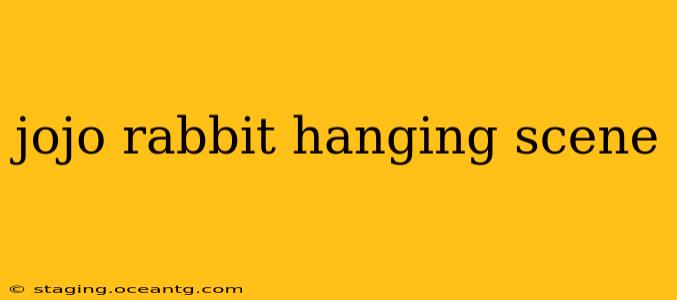Taika Waititi's Jojo Rabbit isn't your typical World War II film. While it tackles the horrors of Nazi Germany, it does so with a unique blend of dark humor and poignant emotion. One of the most impactful scenes, however, is far from comedic: the hanging of a supposed resistance fighter. This scene, though brief, is crucial to understanding the film's central themes and its lasting impact. This post will delve into the significance of this powerful moment, exploring its impact on Jojo, the narrative, and the audience.
What Happens in the Hanging Scene?
The scene depicts a public hanging, orchestrated by the Nazi regime as a display of power and intimidation. While the identity of the hanged man isn't explicitly revealed, the implication is clear: he is a member of the resistance, a threat to the Nazi ideology that Jojo has been indoctrinated to believe. The brutality of the act, though partially obscured, is palpable, leaving a lasting impression on Jojo and the audience.
Why is the Hanging Scene Important?
This scene serves multiple crucial functions within the narrative:
1. Shattering Jojo's Illusions:
Prior to this event, Jojo's understanding of the war and Nazi ideology is largely shaped by propaganda and his idealized view of Captain Klenzendorf (his imaginary friend). The harsh reality of the hanging acts as a brutal awakening, forcing him to confront the violence and cruelty inherent in the Nazi regime. It begins to chip away at the carefully constructed worldview he's been taught.
2. Highlighting the Brutality of War:
The scene starkly contrasts with the film's often playful tone, highlighting the stark reality of war and its devastating consequences. The casual cruelty depicted underscores the inhumanity of the regime and serves as a stark reminder of the real-world atrocities committed during the Holocaust.
3. Undermining Jojo's Blind Faith:
The hanging scene significantly impacts Jojo's relationship with Captain Klenzendorf. The imaginary friend, a manifestation of Jojo's indoctrination, can no longer reconcile the idealized version of Nazism with the horrific reality witnessed. This event marks a turning point in Jojo's disillusionment with the Nazi ideology.
Frequently Asked Questions about the Hanging Scene
Here are some frequently asked questions about the scene, along with detailed answers:
Is the Hanging Scene Graphic?
While the scene doesn't show the hanging in explicit detail, the implications are clear, and the visual impact is undeniably powerful. It's presented in a way that conveys the horror without resorting to gratuitous violence. The focus is more on the impact of the event on Jojo and the overall atmosphere of fear and oppression.
What is the Significance of the Man Being Hanged?
The identity of the hanged man is deliberately left somewhat ambiguous. However, the clear implication is that he is a member of the resistance, representing the opposition to the Nazi regime. His death serves as a warning to others and emphasizes the high stakes of rebellion.
How Does the Hanging Scene Affect Jojo's Character Arc?
The scene acts as a crucial catalyst in Jojo's character arc. It marks the beginning of his disillusionment with Nazism and his gradual journey towards understanding and empathy. The horror of the event forces him to question everything he has been taught.
Why Did Waititi Choose to Include This Scene?
Waititi's inclusion of this scene is a deliberate choice to ground the film's often whimsical tone in the harsh realities of the historical context. It serves as a reminder of the human cost of war and the atrocities committed under the Nazi regime, adding layers of depth and complexity to the narrative. By showing, not just telling, the grim reality of the regime, Waititi forces the audience to confront the uncomfortable truths of history.
In conclusion, the hanging scene in Jojo Rabbit is a masterclass in understated power. It's a crucial moment that underscores the film's themes, propels Jojo's character development, and leaves a lasting impression on the viewer long after the credits roll. It's a reminder of the importance of confronting history's darker chapters and the devastating consequences of hatred and intolerance.
